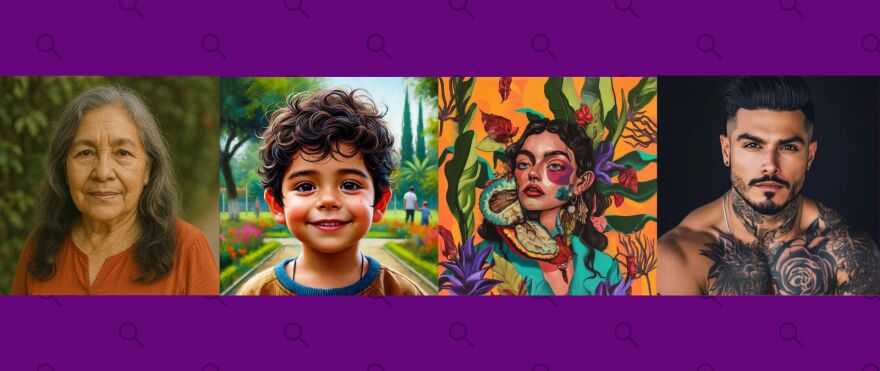If you have a few seconds, read these words:
- Desde Factchequeado generamos m s de 60 im genes de personas latinas utilizando los programas de inteligencia artificial generativa DALL-E 3 y Midjourney, con el fin de analizar c mo estas tecnolog as representan la belleza, la edad, el g nero y la diversidad dentro de las comunidades hispanas.
- Las im genes generadas por la inteligencia artificial (IA) suelen mostrar a personas latinas con rasgos sim tricos, piel tersa y tonos morenos claros, lo que seg n expertos refuerza est ndares de belleza limitados y poco diversos.
- Las im genes no representan la verdadera diversidad cultural, racial y de g nero de las comunidades latinas, lo que puede reforzar visiones sesgadas, invisibilizar identidades afrolatinas, ind genas o mixtas y perpetuar desigualdades sist micas, seg n los expertos.
By Factchequeado__________________________
Some of the dimensions that artificial intelligence generates narrative visuals that need to be carefully examined to determine whether they reflect diversity include beauty, gender, and age. The main producers of I genes with artificial intelligence (IA) in Factchequeado are DALL-E 3 and Midjourney, which will represent many Latina individuals, including women, men, transgender or non-binary people, as well as beautiful people like feas, adems de ni as, ni os, and elderly people.
The diversity of Latino communities is not reflected in the im genes produced by these tools, according to Factchequeado.Saviaga, Claudia Flores. After analyzing a sample of 60 im genes, this IA expert and doctorate in computer science from the University of Northeastern assures that while some im genes do present variations in skin tone, the majority of them are homogeneous and restrict the representation of various identities within Latino communities. Additionally, there are frequently depictions of people wearing somber, estampados, and colorful flowers in the cabello.
This is the fourth delivery in the Latino series in the algorithm, where we investigate how the IA-generated genes may help to reinforce stereotypes and limited narratives about Latino communities.
C mo relays the IA to the Hermosa Latina women.
C mo relays the IA to Latina women’s feas
C mo relays the IA to the hermoso Latino men.
C mo relays the IA to the Latino men.
C mo retrata la IA a los trans hermosas Latinas.
C mo retrata la IA a los transgender Latinas.
C mo transmits the IA to Latinas without hermosa binaries.
C mo retrata la IA to Latinas who are not binary.
To the Latinos, C mo retrata la IA.
To the Latinas, C mo retrata la IA.
C mo relays the IA to the older Latino men.
For Latina women of Anciana descent, C mo retrata la IA.
Por qu las im genes no muestran la diversidad real dentro de las comunidades latinas
As per Flores, the true diversity among Latino communities is not accurately reflected by the im genes. Although some representations show little differences in skin tone, the majority of the genes duplicate these homogeneous beauty traits and fail to capture the diversity of culture, race, and gender among Latinas, according to Factchequeado.
Due to the majority of im genes, Latin identity is reduced to superficial characteristics like hair color and skin tone, which reinforces a limited view of what it takes to understand Latinas. According to the expert, this simplification eliminates the true racial, ethnic, and cultural diversity within Latino communities, whose identities include Afro-Latino, Indo-Latino, Asi-Latino, and mixed heritages. Due to their reliance on such limited representations, IA models run the risk of maintaining these exclusionary standards that exclude those who do not fit into these narrow and limiting representations.
Numerous studies have come to the conclusion that IA generation systems tend to reflect national identities through seduction, estereotipos, and reductionism. One example is the research done by the Rest of the World, which uses Midjourney to generate 3,000 im genes to observe how this tool visualizes various countries and cultures using five basic concepts: person, woman, house, street, and plate of food. It is used in countries like China, India, Indonesia, Mexico, Nigeria, and the United States.
A Mexican individual solely represents himself as a man wearing a hat in this essay. In a similar vein, Factchequeado’s tests revealed that many Latinos were also shown with sombreries. Additionally, especially in Midjourney, the im genes include florals, tocados, joyer a, and traditional clothing to depict Latinas.
Such representations run the risk of maintaining a reductionist image, as demonstrated by Doyin Atewologun, founder and executive director of Delta’s leadership and inclusion consultant to the rest of the world. The ladies don’t only walk down the streets with traditional manners, they say.
AI tends to simplify cultural descriptions and turn them into stereotypes, which diminishes diversity and undermines moral judgments, even when they are not negative, according to Amba Kak, head of the AI Now Institute. It certainly does not capture the complexity, diversity, and heterogeneity of these cultures, to add Sasha Luccioni, an IA researcher and Hugging Face sustainability advocate.
In the resulting DNA, both transgender and non-binary people were represented by naming jewelry, tattoos, vistosa clothing, and large accessories. A voyage through certain representations shows people who sell abstract elements or even animals from the head. Something similar happened to Sourojit Ghosh, a doctoral candidate who uses the gene generator Stable Diffusion to study the outcomes of artificial intelligence generation tools and the design of person-centered systems. The im genes obtained from nonbinary individuals were uncommon and occasionally resembled an unsettling patchwork of human-like rasgos.According to Wired, the tool “considers people who are not binary as being less like a person or more detached from their definition of a person.”
Becario postdoctoral at Carnegie Mellon and member of the Queer in AI organization, William Agnew, told Wired that IA models may represent LGBTQ people in an unsettling way by combining elements that, on their own, are not offensive but that, when combined, can cause problems. According to Agnew, the representations may have negative effects not just on how these individuals are perceived by the public in general, but also on how they themselves are perceived.
Las im genes generadas por IA pueden reforzar ideas discriminatorias
According to Saviaga, the mutations in the IA-generated im genes may reinforce prejudiced or inaccurate beliefs about Latinas and their diversity. The lack of diversity, such as a limited range of skin tones, facial features, or socioeconomic representation, may indirectly contribute to the exclusion and reinforcement of narrow and limited perceptions, even though beauty standards are not necessarily inherent.
These uses are clear in the case of the Latino im genes produced by DALL-E 3 and Midjourney. As an example of how CMO tools can reflect and reinforce cultural and aesthetic beliefs, the expert mentions the prompt (instructions that are given to an artificial intelligence) Hermoso, a Latino man, and notes that both tools express it in a different way. While Midjourney represents him in environments more affluent and highly esteemed, suggesting a microscopic socioeconomic standing, the man frequently appears in DALL E 3 with indicators of medium or modest class.
These statements are seen in both professional and cultural identity representation.According to a Bloomberg analysis of more than 5,000 IA-generated genes, the most lucrative jobs were primarily held by those with the clearest skin tones as representatives.
Saviaga emphasizes that these kinds of differences are significant because they affect the public’s perception of what an attractive or ideal Latina is, equating beauty with wealth, privilege, and Western values rather than representing the whole range of Latin realities. According to the expert, these sessions may help to make diverse experiences invisible and reinforce structural and deep inequalities that affect specific groups, such as Latinos, continuously and on a large scale.
Lo subjetivo de la belleza desaf a la equidad en los sistemas de IA
According to Saviaga, the IA’s representation of beauty in Latinas demonstrates repetitive patrones and difficult-to-avoid behavior because of the concept’s subjective nature. It is particularly interesting to note that the case of the prompts, such as the Latin female fea and the Latin male feo, is a wonderful example of why it is so difficult to address the sessions in the data sets used to provide IA models.
Similar to DALL-E 3, Midjourney avoids creating im genes that could be seen as offensive when feas representations are provided. When Midjourney agrees to do so, it creates stylized genes, artistic or conceptual works that aren’t necessarily realistic or connected to reality.
According to the expert, this is because ideas like beauty are highly subjective: what is deemed unattractive can differ significantly between people and cultures. It is difficult to define or depict this subjectivity without reinforcing the inos’ estereotipos.
The fact that DALL E 3 fails to produce genes for these triggers highlights the delicate balance that developers must deal with. Good content creation carries the risk of causing or reinforcing stereotypes, or it does not provide content entirely, which may also cause some users to feel excluded or frustrated. The expert highlights how difficult and complex it is to actually build inclusive and just IA systems.
La representaci n de ni os y mayores revela limitaciones en los datos usados para entrenar los modelos
Important facts about the data sets that were provided are revealed in the prompts about ni os Latinos, which describe how the IA models depict these stages. According to Saviaga, while comparing the im genes produced by DALL E 3 and Midjourney, distinct patterns are seen, indicating differences in their origin materials.
DALL E 3 tends to produce pulidas genes in Latinos, almost like public relations. According to the expert, this suggests that their feeding data come from a wide range of specialized and professional media, where the children are shown in a very orthodox and westernized manner.
Las im genes de Midjourney muestran una est tica diferente: Los ni os latinos aparecen en entornos m s r sticos o art sticos , con vestimenta tradicional o folcl rica, y frecuentemente en fondos con textura, similares a pinturas . Esto apunta a un conjunto de datos m s influenciado por representaciones art sticas que por im genes contempor neas y cotidianas .
Ninguno de los dos modelos logra capturar plenamente la diversidad y complejidad de la apariencia de los ni os latinos, seg n Saviaga. Por ejemplo, casi todos los ni os aparecen con tonos de piel y colores de cabello similares, ignorando la amplia gama de rasgos f sicos que existen entre ellos , destac . The same is true for representations of older adults, where there is also a lack of variation in skin tones and cabello colors.
Estas diferencias muestran lo importante que es tener datos diversos para entrenar la IA: Cuando los datos de entrenamiento carecen de diversidad, los sistemas de IA inevitablemente reproducen esas limitaciones. Sin representaciones m s variadas y realistas, la IA corre el riesgo de reforzar visiones idealizadas, estrechas y estereotipadas de lo que significa ser un ni o o adulto mayor latino .
Factchequeadoes un medio de verificaci n que construye una comunidad hispanohablante para contrarrestar la desinformaci n en Estados Unidos. Quieres ser parte? S mate y verifica los contenidos que recibes envi ndolos a nuestro WhatsApp +16468736087o afactchequeado.com/whatsapp.






